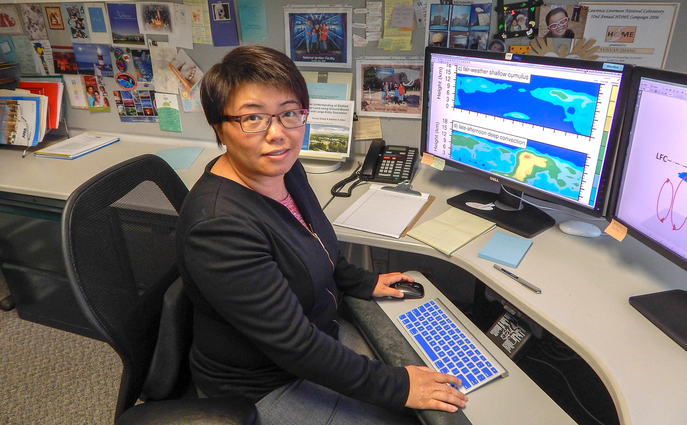Lawrence Livermore climate scientist earns Early Career Research award
 (Download Image)
Lawrence Livermore climate scientist Yunyan Zhang has earned $2.5 million for research to improve the understanding of how soil moisture and surface diversity affect cloud formation and precipitation. Photo by Julie Russell/LLNL
(Download Image)
Lawrence Livermore climate scientist Yunyan Zhang has earned $2.5 million for research to improve the understanding of how soil moisture and surface diversity affect cloud formation and precipitation. Photo by Julie Russell/LLNL
Lawrence Livermore’s Yunyan Zhang, a climate scientist in the cloud process group within the Atmospheric, Earth and Energy Division, has earned $2.5 million for research to improve the understanding of how soil moisture and surface diversity affect cloud formation and precipitation.
As the recipient of the Department of Energy Early Career Research Program (ECRP), Zhang will receive $500,000 for five years to support the development of her research titled, "The Effect of Soil Moisture and Surface Heterogeneity on Clouds and Precipitation: Inferences from ARM Observations and Large Eddy Simulations." Zhang’s project was selected by the Office of Biological and Environmental Research.
The DOE’s Early Career Research Program, now in its sixth year, is designed to bolster the nation’s scientific workforce by providing support to exceptional researchers during the crucial early career years, when many scientists do their most formative work.
"The good news came as a surprise. I feel so honored and thrilled to receive this highly competitive award," Zhang said. "It has been extremely lucky for me to work with my mentor and my colleagues in the cloud processes group and the Program for Climate Model Diagnosis and Intercomparison (PCMDI). Their outstanding work and dedication on climate science inspired me in many ways in the past eight years. I am so honored to be here among them at the Lab."
Zhang’s specific interests include clouds and convection; low-cloud climate feedback; aerosol indirect effect and land-atmosphere interaction.
"It has always been fascinating for me to study the life cycle of clouds," she said. "I make observational analysis using both in-situ and remote sensing data from field campaigns or long-term observations at DOE Atmospheric Radiation Measurement (ARM) climate facilities. "
She performs numerical modeling and analysis using fine-scale modeling tools such as large eddy simulations (LES), as well as global climate models (GCM) with parameterized cloud and convection processes or super-parameterization such as Multi-scale Modeling Framework (MMF).
Zhang received her bachelor’s degree in atmospheric sciences from Peking University, Beijing, China and her Ph.D. in atmospheric sciences from the University of California, Los Angeles.
This year,DOE selected 44 awardees; 27 awardees were at universities and 17 at National Laboratories.
Zhang joins the Lab’s 12 previous ECRP award winners: Jennifer Pett-Ridge and Todd Gamblin in 2014; Yuan Ping in 2013; Céline Bonfils, Gianpaolo Carosi, Andreas Kemp, and Jaime Marian in 2012; Yongqin Jiao, Peter Lindstrom and Sofia Quaglioni in 2011; and Vlad Soukhanovskii and Greg Bronevetsky in 2010.
Soukhanovskii completed his ECRP magnetic fusion energy project in April of this year, saying it was "a success, completed safely, on time and on budget." His accomplishments include:
- Experimental research work was carried out on two magnetic fusion devices (tokamaks) — the National Spherical Torus Experiment (NSTX) at Princeton Plasma Physics Laboratory, Princeton, New Jersey, and DIII-D at General Atomics in San Diego.
- Two postdocs and one staff were hired and partially supported by ECRP funding (excluding the PI).
- Scientific results generated by the project were reported in nine talks at scientific conferences over five years, and resulted in numerous contributions to scientific papers.
- The funding enabled numerical modeling, equipment purchases and apparatus development that are expected to provide major contributions to magnetic fusion research at the NSTX-Upgrade device at Princeton Plasma Physics Laboratory, Princeton, New Jersey.
Contact
 Anne M. Stark
Anne M. Stark
[email protected]
(925) 422-9799
Related Links
Yunyan ZhangProgram for Climate Model Diagnosis and Intercomparison
DOE Early Career Research Program
Tags
ClimatePhysical and Life Sciences
Careers
Featured Articles







